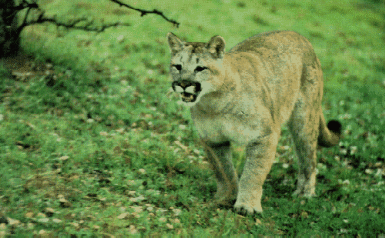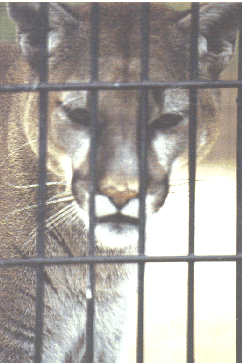
by: Mark Pulsifer
SUMMER/FALL 1992

The fate of the eastern cougar continues to be a matter or speculation.
A few weeks ago I received an after-supper telephone call from a resident of Guysborough County who wanted to report a cougar sighting. As I listened to the caller and scribbled down the information, I quickly recalled the dozen or so similar reports that I had received since coming to this area four years ago.
"Now let me see if I understand you correctly," I said to the voice on the other end of the line. "You say you saw this animal around mid-morning. It was large, about 90 pounds, light brown with a flat, cat-like face and a long, thick tail that curled up over its back when it ran."
"That's correct," came the reply. "Oh ... there is one more thing. I was only 10 feet away from the animal, and I watched it lying in a ditch for almost two minutes." Now this last bit of information really had my curiosity piqued. Most sightings are merely fleeting glimpses of unidentifiable creatures at night, or of animals behind heavy cover or a considerable distance away. To be so close to an animal of that description for so long a period is extremely unusual and, in my mind, removes a good deal of the doubt about misidentification.
It had rained two days before, so I asked the caller if he could show me the exact location of the sighting so that we could look for tracks. After a considerable pause I was told that the exact location was no problem; unfortunately, the sighting itself was now over one month old. My disappointment at this news was evident. However, I thanked the caller and added this sighting to my ever expanding file on cougar sightings for Guysborough County.
This one particular sighting happened to be a very credible one, and although it didn't bring us any closer to undeniable proof of cougar existence in Nova Scotia, I couldn't help wondering just what people are seeing.
Most cougar sightings are remarkably consistent. Nearly all report seeing a large cat-like animal, tawny to black in color with a long, curved tail. Of special interest is the unusually high number of black or melanistic cougars reported in the province. Black cougars have been reported 42 times in Nova Scotia and 49 times in New Brunswick. In South America where the black form is endemic, it is considered very rare. This unusually high rate of observed melanism in Nova Scotia has led some to suggest that the dark coloration of these animals is due to back lighting and/or the result of a wet pelt.
The eastern cougar is known by many names-panther, painter, puma, mountain lion, or carcajou. It is officially listed as an endangered species by the Committee on the Status of Endangered Wildlife in Canada (COSEWIC) and receives full protection in Nova Scotia. The last documented cougar specimen taken in eastern North America was trapped in Maine near the Quebec border in 1938.
Among predators this mysterious and elusive cat is second only to the bear in size and can reach 2.2 m (7 ft.) in total length and weigh 90 kg (200 Ibs.). Males are considerably larger than females. Like most cats, cougars have a long body, short face, small rounded ears, and a long, rope-like tail that averages 76 cm (30 in.) in length.
Cougars are loners-except during breeding or when mothers are accompanied by their kittens. Hunting is done over a territory of about 80- 1 00 kM² (30-40 sq. mi). Little is known about the breeding biology of the eastern cougar. Its western counterpart, however, will bear two to four kittens, generally in late winter or mid-summer. The kittens will stay with their mother, learning to hunt, until they are about a year old.

Prior to the arrival of Europeans the cougar was one of the most common predators in the New World. It occupied a variety of habitats ranging from lowland swamps to mountain regions, semi-arid deserts to bush woodlands. Cougars could once be found from the British Columbia/Yukon border, to the southern tip of South America, and from the Pacific to the Atlantic. Today there are two subspecies of cougar recognized in Canada-the eastern race and the larger western race.
The debate over whether cougar have ever lived in Nova Scotia goes back many years. Some authors (Farley Mowatt) maintain that the eastern cougar once inhabited all of the Atlantic provinces except Newfoundland prior to the arrival of Europeans and that subsequent to their arrival, cougars were trapped, shot, poisoned, and hounded into extinction.
However, there are no historical records of cougar specimens in Nova Scotia. To those familiar with the history of big game in Nova Scotia and the feeding behaviour of cougars, this may come as little surprise. The preferred food of cougar is deer, and in Nova Scotia the white-tailed deer was extinct for many years before the arrival of Europeans. White-tailed deer were not reintroduced to Nova Scotia until the turn of this century.
A small breeding population of cougar exists today in Florida, but the fate of cougar in the northeast continues to be a matter for speculation. Is it possible that a small number of cougar survived and even now are re-establishing themselves over their former range?
One biologist, Dr. Bruce Wright, thought so. From 1948 to 1971 evidence from 220 cougar reports from New Brunswick and 26 from Nova Scotia were documented. Based on this evidence Wright estimated that by 1972 there were approximately 100 cougar in eastern North America, including the 25-50 living in Florida. On the strength of these estimates in 1977 the Canadian Wildlife Service initiated a process to formally document cougar sightings in the Maritime region. Since that time over 425 reports from Nova Scotia and New Brunswick have been filed. Over 265 of these reports are from Nova Scotia, with the majority reported from the eastern half of the province. A number of these reports have resulted in comprehensive investigation. Unfortunately none has brought us conclusive evidence of cougar existing in either Nova Scotia or New Brunswick. While many reports of cougars have been nothing more than house cats, deer, coyotes, or tracks made by two-litre pop bottles, there have been a number of sightings and even encounters with animals that would support the existence of these large mysterious animals.
One of the most intriguing of these was recently reported in an article on cougar by John Sansom in the spring 1992 issue of Eastern Woods and Waters. Apparently in 1985, a family, while driving from Shelburne to Lunenburg, struck a huge cat approximately 2.8 m (6 ft.) in length (not including the tail). Not knowing if the animal was dead or alive the family proceeded to drag the 7090 kg (150-200 Ibs.) animal to the shoulder of the road before heading on.
In 1979 an experienced woodsman and taxidermist with the Nova Scotia Museum prepared wax casts of suspected cougar tracks from Belmont Mountain, Colchester County. These same casts were later found to be near identical to similar casts made from cougar at the wildlife park in Shubenacadie.
Just this past June a report came to the Department of Lands and Forestry in western Cape Breton that a young cougar had fallen into a well and drowned. The owner removed the carcass from the well and left it nearby until he could report it Monday morning. When the site was visited Monday, the carcass was gone. No trace, except the smell-no blood or fur or tissue. The observer described the cat as a young cougar .6-.75 m (2-2 1/2 ft) long, greyish brown, and with long legs-30 cm(l 2 in.) from knees to toe. He didn't recall seeing the tail. However, he was convinced that it wasn't a domestic cat or a bobcat. Without the carcass or any evidence the investigation remains inconclusive.
If cougar do exist in Nova Scotia, they are probably few in number, which may explain the scarcity of good physical evidence. The health of any animal population is partly related to food and habitat availability. An increase in prey resources should be reflected by an increase in predator species that utilize those prey. Although cougar eat a wide variety of food items, deer are by far their choice for a meal. During the early 1980s deer numbers climbed in Nova Scotia until the herd reached a peak in 1985. If cougar were living here at that time they should have responded favourably to these increases, thereby increasing the likelihood of obtaining conclusive sightings and/or physical evidence.
While cougar have been known to occupy a variety of habitats, their long-term survival depends on wilderness areas. Nova Scotia's land use patterns have virtually eliminated most of the wilderness areas from the province. Extensive roading has opened up much of the province. Forest management practices exercised in Nova Scotia have been a mixed blessing for cougar, if they do exist here. Forest operations have in general created favourable conditions for deer, but at the expense of wilderness areas.
Obviously the future of the eastern cougar is uncertain. Although biologists are still waiting for undeniable evidence of the cougar's existence in the Maritimes, few are prepared to rule out the possibility altogether. At present, federal and provincial biologists have formed an eastern cougar recovery team whose mandate is to determine first whether or not there is a viable population of eastern cougar in Nova Scotia and New Brunswick. In the meantime, those of us who travel the woods either by profession or for recreation should continue to be on the lookout for tracks, hair, or other physical remains. Maybe it is only a matter of time before someone stumbles upon that undeniable proof of this great cat's existence or are we truly chasing a ghost?